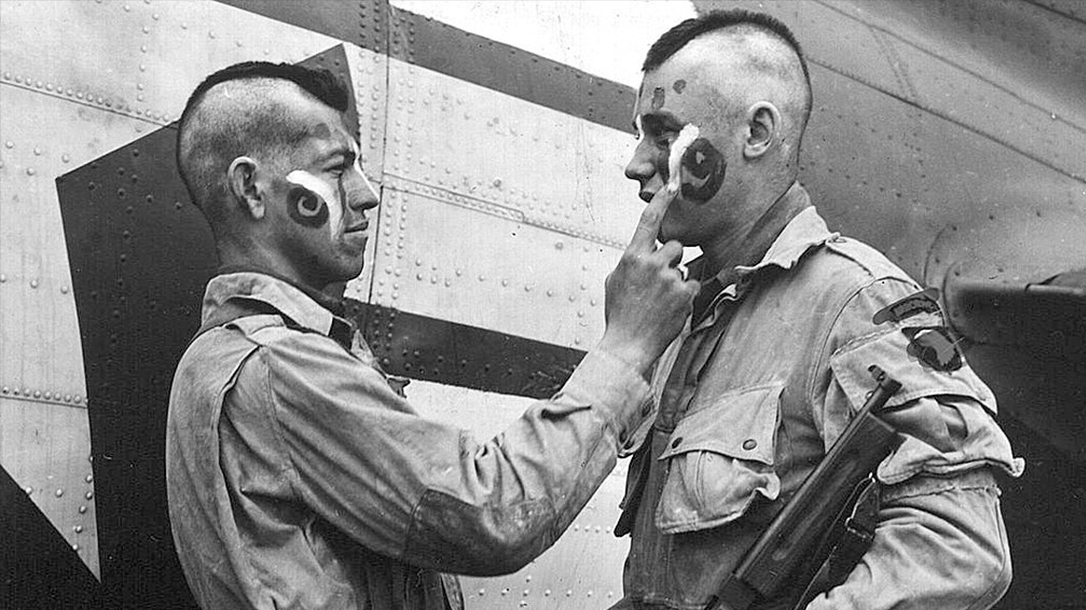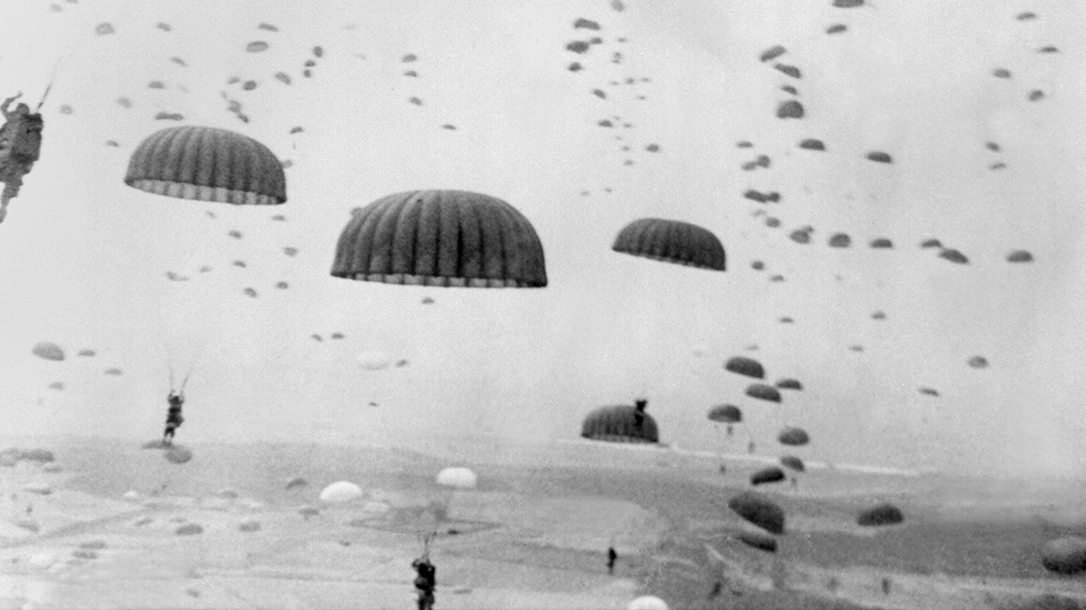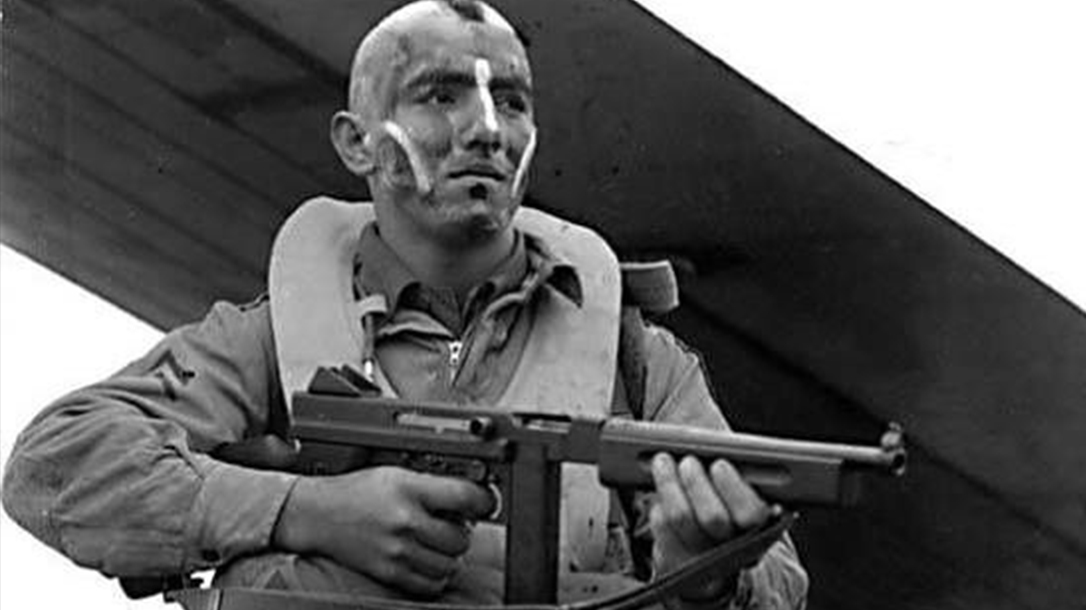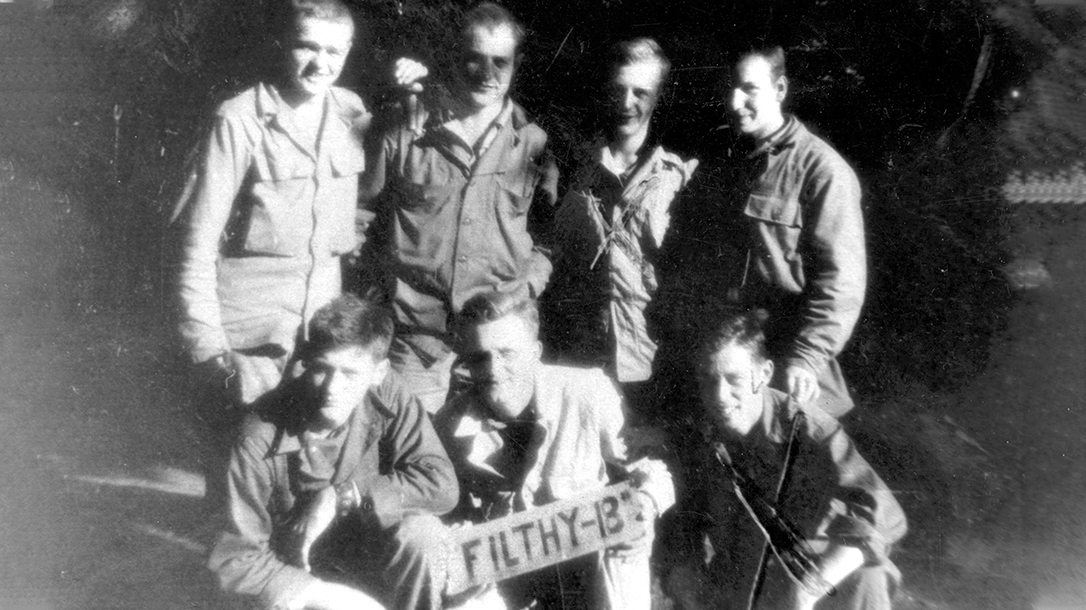Thirty-six years before Joe Strummer of The Clash sported a mohawk with his band of rebels and waged musical war against the mainstream, a band of dirty demolition experts shaved their own mohawks, smeared on war paint, strapped explosives, knives, pistols, rifles and parachutes to their bodies and boarded a C-47 bound for Normandy to wage a real war. Their one objective: To kill every Nazi they encountered by hand, blade, bullet or explosive. They were a demolition squad known for skipping showers and formations. They would fight in several historical battles and blaze a trail of freedom through Europe. Known to all as the “Filthy Thirteen,” they were the real-life Dirty Dozen.
Memorable Beginnings
Among the greatest images of World War II are the few photos of a demolition squad from the 506th Parachute Infantry Regiment, 101st Airborne Division. These men shaved their hair into mohawks and donned war paint just hours before jumping into certain battle with the German army on D-Day. They fought dirty and struck first. During pre-deployment training, three Filthies dressed as the opposing-force officers. Later, they infiltrated their ops order meeting and captured the chain of command.

Only weeks before deploying, the leader of this unwashed, hard-charging outfit blew up part of their barracks. He then stole a train while drunk in town, drove it back to base and spent numerous rotations in the stockade for fighting and disrespecting officers. His name was Jake McNiece, the son of an Irish Catholic father and Native American mother. He charged members in his squad initiation fees and was the meanest, drunkest and filthiest of the Thirteen. Once, he defeated an MP and used his sidearm to shoot out streetlights.
Different Walks of Life
The antithesis to Jake McNiece was non-drinking Ranger Jack Womer. He attended a condensed 10-day Airborne School where he did four of his five mandatory jumps in one day. McNiece recognized Womer as a hard charger and asked him to be part of his demolition squad. The two would go on to jump together into Normandy and Holland and to fight in Bastogne. Their unit was the inspiration for the book and hit film “The Dirty Dozen.”
They were also the two longest-living members of the Filthy Thirteen who, fortunately for Americans, penned their experiences in their autobiographies: “The Filthy Thirteen: From the Dustbowl to Hitler’s Eagle Nest: The 101st Airborne’s Most Legendary Squad of Combat Paratroopers” by Richard Killblane and Jake McNiece and “Fighting with the Filthy Thirteen” by Jack Womer and Stephen Devito.
The Sham Story of the Century
Prior to Operation Overlord, the 101st Airborne were to conduct a demonstration jump for the new division commander, General Taylor, Supreme Allied Commander Dwight Eisenhower, and Prime Minister Winston Churchill. To avoid the toy-soldier antics of marching and formations, Womer and a cohort participated in the jump but as soon as they hit the ground, they hid their parachutes and themselves in a large haystack in the middle of the drop zone. After an hour or so, a car stopped beside the haystack and Winston Churchill exited the vehicle. The two motionless paratroopers could see General Taylor and Eisenhower seated in the vehicle. To the hidden soldiers’ surprise, Churchill unzipped his pants and relieved himself with a steady stream through the stacked hay onto Womer’s unseen boots. Churchill, unaware, zipped up his pants, re-entered the car and the leaders drove away.

Midnight Rain of Screaming Eagles
For their part in Operation Overlord, the mohawked Filthy Thirteen flew in the night sky surrounded by spheres of fire. With planes exploding and tracer rounds screaming through the hull of their C-47—one even striking a member’s reserve chute, causing it to deploy—they exited the door into known threats in the sky only to land into the unknown threats of the man-made marshes of German General Rommel. As soon as the men could perform their parachute landing falls, or just simply smack the earth with their fourth point of contact, they were up and clicking their “crickets” to locate fellow paratroopers in the night.
PFC Womer linked up with 501st Parachute Infantry Regiment. He led 30 of them out of the marsh. Having had no sleep for 24 hours, he moved through a barrage of bullets and mortar attacks and helped round up 20 paratroopers to build a defensive perimeter. He also rescued a crying 12-year-old boy and assisted in capturing 350 German POWs. The 501st then cleared out the elite SS from Carentan, where Womer rallied with the remaining Filthy Thirteen.
Capture and Chaos
Robert Cone, a Jewish member, was also separated from his fellow Filthies during the initial jump. Suffering from a gunshot wound, he fled out of sight from the enemy, removed his dog tags, pushed them into the soft ground and ran undetected into a barn where he hid for two days until the family that owned the farm gave him up to the Nazis. He endured nine months in a prison camp before being liberated by the Russians. He and a cohort fought alongside the rescuing Russian unit for a week and then made their way across Poland, Romania and Russia on their own, using stolen Polish money. Once in Russia, they were jailed for not having identification but were later released and boarded a British ship to Egypt. There, they were wrongfully jailed during a mutiny fiasco but, finally, were sent to the U.S.

As for McNiece and a few others during D-Day, they linked up sporadically with squads from the 501st and the 502nd, pushed on to secure a bridge and attacked the town of Carentan. In one house, a German’s weapon ran dry and McNiece swung his M1 like Babe Ruth and ended the fight for the Nazi. The men continued through and took the city. To reward themselves for their efforts, the pilfering paratroopers blew open safes, obtained riches and, of course, more alcohol.
Only six of the original Filthy Thirteen from the D-Day invasion remained active and prepped for the next jump. Four had been killed and three had been captured. They now prepped for Operation Market Garden.
Operation Market Garden
Over Holland, aboard a C-47 nicknamed “Ridge Runner,” history repeated itself and the daytime sky was active with incoming rounds into the belly and wings of the airplanes ready to release their payloads of Screaming Eagles. To avoid certain death in the sky, the Filthy Thirteen jumped before the green light was on.
They floated down through intermittent anti-aircraft gunfire, rallied up with the other 506 PIR units, crossed canals with makeshift rafts, fought their way through tanks and infantry, and removed German explosives from bridges. Improvising and always pushing forward, McNiece acquired an abandoned German truck and drove his men into town. There, McNiece and men dodged 88mm rounds and fought house to house until they were victorious.

Fewer In Numbers
After Holland, the number of the original Filthies dwindled even smaller. Jake McNiece, Jack Agnew and others transferred to the Pathfinders. It was a small, elite team of paratroopers who were the first to jump into enemy territories. McNiece led the Pathfinders on a combat jump into Bastogne. They secured a position within eyesight of the Nazis. Using the classified CRN-4 transmitter, Agnew called in airdrops of ammunition and food to the 101st Airborne, who were surrounded by German divisions. These airdrops kept the Screaming Eagles supplied and avoided certain defeat in the Battle of the Bulge. They then jumped into St. Vith to do the same for the depleted 90th Infantry.
Womer survived Bastogne and deployed to the Alps, where his demo squad was ambushed by mortar fire. Womer, armed with only a knife, a pistol and two grenades, scaled the mountainside. There he coordinated a fire mission that killed eight Nazis and saved his squad. This occurred the day after the war in Europe had officially ended, the final patrol for the original Filthy Thirteen.
The annals of World War II had no shortage of bravery under fire in the most extreme combat circumstances. The Filthy Thirteen remain some of the most audacious on record in this, or any war.
If you like stories of bravery like this one, please visit outdoorgroupstore.com to subscribe. Also check out our weekly podcast, Skillset Live!






















